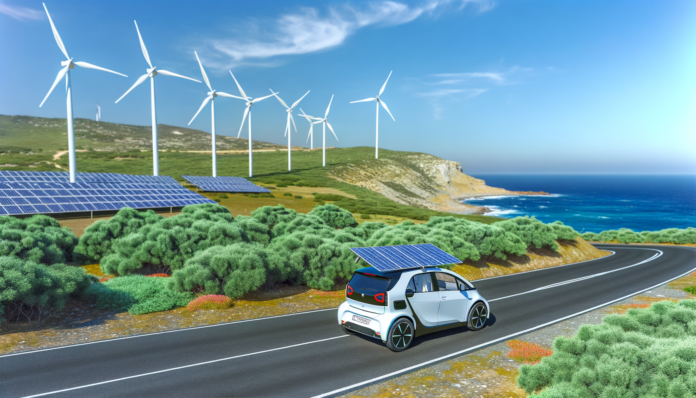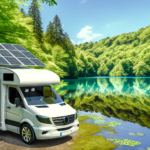Introduction to Sustainable Travel
The Growing Importance of Eco-Friendly Travel
In the 21st century, travel is undergoing a significant transformation, driven by technological advancements and a growing awareness of environmental sustainability. Gone are the days when travel was solely about reaching a destination; today, it encompasses a broader spectrum of experiences that prioritize both enjoyment and responsibility. The intersection of cutting-edge innovations and eco-conscious practices is reshaping tourism, creating a profound bond between wanderlust and environmental health.
As travelers become more aware of their environmental footprint, the demand for eco-friendly travel options has surged. This shift is not just about reducing carbon emissions but also about embracing a holistic approach to responsible tourism. From choosing eco-friendly accommodations to using apps that track carbon offsets, technology is playing a pivotal role in promoting sustainable travel practices. The rise of sustainable tourism is not merely a trend but a necessary evolution to ensure that future generations can enjoy the beauty of our planet.
The Role of Solar Power in Sustainable Journeys
Among the various technologies driving sustainable travel, solar power stands out as a game-changer. Solar energy, harnessed through photovoltaic panels, offers a clean, renewable source of power that can significantly reduce the environmental impact of travel. The integration of solar power into travel technology is paving the way for more eco-friendly journeys, providing travelers with the means to explore the world while minimizing their carbon footprint.
Solar power solutions for travelers come in various forms, from portable solar panels to solar-powered gadgets and vehicles. These innovations enable travelers to generate their own clean energy, whether they are camping in remote locations or exploring urban landscapes. Portable solar panels, for instance, allow adventurers to charge their devices on the go, eliminating the need for traditional power sources that rely on fossil fuels. Solar-powered gadgets, such as lanterns and chargers, further enhance the travel experience by providing reliable, sustainable energy solutions.
Moreover, solar-powered vehicles are revolutionizing the way we think about transportation. Electric vehicles (EVs) equipped with solar panels can extend their range and reduce dependency on charging stations, making them ideal for long-distance travel. This not only reduces greenhouse gas emissions but also promotes energy independence, allowing travelers to explore off-the-beaten-path destinations without worrying about fuel availability.
In conclusion, the growing importance of eco-friendly travel and the role of solar power in sustainable journeys cannot be overstated. As we continue to innovate and embrace greener technologies, the future of travel looks promising, with endless possibilities for exploring the world responsibly. By integrating solar power into our travel practices, we can embark on sustainable journeys that leave a positive impact on the environment and inspire others to do the same.
Understanding Solar Power
Basics of Solar Energy
Solar energy is a renewable and abundant source of power derived from the sun’s radiation. This energy can be harnessed and converted into electricity or heat, making it a versatile and sustainable option for various applications. The sun emits energy in the form of light and heat, which can be captured using different technologies to generate power. Solar energy is considered one of the cleanest forms of energy because it produces no greenhouse gas emissions during operation, thus contributing significantly to the reduction of carbon footprints.
How Solar Panels Work
Solar panels, also known as photovoltaic (PV) panels, are devices that convert sunlight directly into electricity. They are composed of many solar cells made from semiconductor materials, typically silicon. When sunlight hits these cells, it excites electrons, creating an electric current. This process is known as the photovoltaic effect.
1. **Absorption of Sunlight**: Solar cells absorb photons from sunlight, which then energize electrons in the semiconductor material.
2. **Generation of Electric Current**: The energized electrons move through the material, creating an electric current.
3. **Conversion to Usable Power**: This direct current (DC) electricity is then converted to alternating current (AC) using an inverter, making it suitable for use in homes and businesses.
Solar panels can be installed on rooftops, open fields, or integrated into building materials, making them a flexible solution for generating renewable energy.
Types of Solar Power Solutions for Travelers
Travelers can benefit from various solar power solutions designed to provide energy on the go. These solutions range from portable solar panels to solar-powered gadgets and vehicles, each catering to different needs and preferences.
1. **Portable Solar Panels**: These are lightweight, foldable panels that can be easily carried and set up to charge devices like smartphones, cameras, and laptops. They are ideal for camping, hiking, and other outdoor activities where access to electricity is limited.
2. **Solar-Powered Gadgets and Accessories**: A variety of gadgets, such as solar chargers, power banks, and lanterns, are available to ensure that travelers have a reliable source of power. These devices harness solar energy to charge batteries, providing a sustainable way to keep electronic devices operational.
3. **Solar-Powered Vehicles**: For those who prefer road trips, solar-powered vehicles offer an eco-friendly alternative to traditional fuel-powered cars. These vehicles are equipped with solar panels that charge the battery, reducing the need for frequent stops at charging stations and minimizing environmental impact.
By understanding the basics of solar energy, how solar panels work, and the types of solar power solutions available, travelers can make informed decisions to incorporate sustainable practices into their journeys. This not only enhances their travel experience but also contributes to a greener planet.
Benefits of Solar-Powered Travel
Environmental Impact
Solar-powered travel significantly reduces the environmental footprint of our journeys. Traditional travel methods, reliant on fossil fuels, contribute to greenhouse gas emissions, air pollution, and global warming. By harnessing solar energy, travelers can minimize these adverse effects. For instance, Cochin International Airport in Kerala, India, has set a remarkable precedent by becoming the world’s first fully solar-powered airport. This initiative not only meets the airport’s energy needs but also contributes surplus power back to the grid, showcasing a sustainable model for other airports globally.
Solar energy is a clean, renewable resource that does not produce harmful emissions during its generation. This makes it an ideal solution for reducing the carbon footprint associated with travel. By integrating solar power into travel infrastructure, such as vehicles, gadgets, and accommodations, we can significantly cut down on the pollution and environmental degradation caused by conventional energy sources.
Cost Savings
One of the most compelling benefits of solar-powered travel is the potential for substantial cost savings. While the initial investment in solar technology can be high, the long-term financial benefits are considerable. Solar panels and solar-powered devices can drastically reduce or even eliminate the need for traditional energy sources, leading to lower energy bills.
For example, Cochin International Airport saves millions annually on electricity costs by utilizing solar power. The airport not only reduces its operational expenses but also generates additional revenue by selling excess energy back to the grid. This dual benefit of cost reduction and revenue generation makes solar power a financially viable option for travelers and travel-related businesses.
Moreover, solar-powered travel reduces the dependency on fluctuating fuel prices. Once the solar infrastructure is in place, the energy harnessed from the sun is free, providing a stable and predictable energy cost. This is particularly beneficial for long-term travelers and those who frequently venture off-grid, where access to traditional energy sources can be limited and expensive.
Energy Independence
Solar-powered travel offers a significant degree of energy independence. Travelers equipped with portable solar panels, solar-powered gadgets, and solar-integrated vehicles can generate their own power, reducing reliance on external energy sources. This independence is particularly advantageous in remote or off-grid locations where access to electricity is limited or non-existent.
Energy independence also enhances the reliability and convenience of travel. For instance, adventurers using solar power can charge their devices, power their campsites, and even run essential appliances without worrying about finding a power source. This self-sufficiency not only makes travel more enjoyable but also safer, as it ensures a continuous supply of energy for communication, navigation, and emergency equipment.
In conclusion, the benefits of solar-powered travel are multifaceted, encompassing environmental sustainability, cost savings, and energy independence. By adopting solar technology, travelers can enjoy a more eco-friendly, economical, and self-reliant journey, paving the way for a sustainable future in travel.
Innovative Solar Technologies for Travelers
### Portable Solar Panels
Portable solar panels have revolutionized the way travelers harness renewable energy on the go. These compact, lightweight devices are designed to capture solar energy and convert it into electricity, making them an ideal solution for eco-conscious adventurers. **Portable solar panels** can be easily packed and set up at campsites, on RVs, or even during long hikes, providing a reliable source of power for various electronic devices.
**Key Features:**
– **Lightweight and Compact:** Modern portable solar panels are designed to be lightweight and foldable, making them easy to carry and store.
– **High Efficiency:** Advances in solar technology have led to the development of highly efficient panels that can generate significant power even in less-than-ideal sunlight conditions.
– **Versatility:** These panels can charge a wide range of devices, from smartphones and cameras to portable batteries and laptops.
**Benefits:**
– **Environmental Impact:** By using solar energy, travelers can reduce their reliance on fossil fuels and minimize their carbon footprint.
– **Energy Independence:** Portable solar panels provide a sense of energy independence, allowing travelers to venture off-grid without worrying about power sources.
– **Cost Savings:** Over time, the use of solar panels can lead to significant savings on energy costs, especially for long-term travelers.
### Solar-Powered Gadgets and Accessories
The market for solar-powered gadgets and accessories has expanded significantly, offering travelers a variety of eco-friendly options to enhance their journeys. These innovative products harness solar energy to power everyday devices, reducing the need for disposable batteries and conventional electricity.
**Popular Solar-Powered Gadgets:**
– **Solar Chargers:** These devices can charge smartphones, tablets, and other small electronics using solar energy. They are perfect for backpackers and campers who need to keep their devices powered in remote locations.
– **Solar Lanterns:** Ideal for camping and outdoor activities, solar lanterns provide reliable lighting without the need for batteries or electricity. Many models also feature USB ports for charging other devices.
– **Solar Backpacks:** Equipped with built-in solar panels, these backpacks can charge electronic devices while on the move, making them a practical choice for hikers and travelers.
**Advantages:**
– **Sustainability:** Solar-powered gadgets reduce the need for disposable batteries, which can be harmful to the environment.
– **Convenience:** These devices offer a convenient way to keep electronics charged, especially in areas without access to electricity.
– **Innovation:** The growing range of solar-powered products reflects ongoing innovation in the field of renewable energy, providing travelers with more sustainable options.
### Solar-Powered Vehicles
Solar-powered vehicles represent a significant advancement in sustainable travel, offering an eco-friendly alternative to traditional fuel-powered transportation. These vehicles use solar panels to convert sunlight into electricity, which powers the vehicle’s motor and other systems.
**Types of Solar-Powered Vehicles:**
– **Solar-Powered Cars:** While still in the early stages of development, solar-powered cars are designed to use solar panels integrated into the vehicle’s body to generate electricity. These cars can reduce dependence on fossil fuels and lower greenhouse gas emissions.
– **Solar-Powered Bicycles:** Solar-powered e-bikes are equipped with solar panels that charge the bike’s battery, providing an extended range and reducing the need for frequent recharging.
– **Solar-Powered Boats:** Ideal for eco-friendly water travel, solar-powered boats use solar panels to generate electricity for propulsion and onboard systems, offering a quiet and emission-free alternative to traditional boats.
**Benefits:**
– **Environmental Impact:** Solar-powered vehicles produce zero emissions, making them a sustainable choice for reducing the carbon footprint of travel.
– **Cost Efficiency:** By utilizing free solar energy, these vehicles can significantly reduce fuel and maintenance costs over time.
– **Innovation and Awareness:** The development and use of solar-powered vehicles highlight the potential of renewable energy in transforming the transportation sector, raising awareness about sustainable travel options.
In conclusion, the integration of innovative solar technologies into travel not only enhances the convenience and efficiency of journeys but also promotes a more sustainable and eco-friendly approach to exploring the world. By embracing portable solar panels, solar-powered gadgets, and solar-powered vehicles, travelers can significantly reduce their environmental impact and contribute to a greener future.
Case Studies: Successful Solar-Powered Journeys
Adventurers Using Solar Power
In recent years, a growing number of adventurers have turned to solar power to fuel their journeys, demonstrating the viability and benefits of renewable energy in even the most challenging environments. One notable example is the Solar Impulse project, led by Swiss explorers Bertrand Piccard and André Borschberg. Their solar-powered aircraft completed a historic round-the-world flight, covering over 40,000 kilometers without using a single drop of fossil fuel. This groundbreaking journey showcased the potential of solar energy in aviation and inspired countless others to consider renewable energy for their own adventures.
Another inspiring story is that of Sarah Outen, a British adventurer who circumnavigated the globe using human power and solar energy. During her journey, she relied on portable solar panels to charge her electronic devices, including GPS, communication equipment, and cameras. This not only reduced her reliance on non-renewable energy sources but also highlighted the practicality and reliability of solar power in remote and off-grid locations.
Off-Grid Living with Solar Energy
Off-grid living has become increasingly popular among those seeking a sustainable and self-sufficient lifestyle. Solar energy plays a crucial role in enabling individuals and communities to live independently from traditional power grids. One exemplary case is the Govardhan Ecovillage (GEV) in India. With two solar power plants boasting a total capacity of 300 kW, GEV fulfills over 55% of its energy requirements through solar power. Annually, these installations save approximately 268 tonnes of CO2 emissions, equivalent to planting around 13,500 teak trees. This initiative not only reduces the community’s carbon footprint but also serves as a model for integrating solar energy into sustainable living practices.
In the United States, the Earthship Biotecture community in New Mexico has also embraced solar energy as a cornerstone of its off-grid lifestyle. Earthships are self-sustaining homes built from recycled materials and designed to harness solar power for electricity, heating, and cooling. These innovative structures demonstrate how solar energy can be seamlessly integrated into eco-friendly housing, providing a blueprint for sustainable living that minimizes environmental impact.
Solar-Powered Expeditions
Solar-powered expeditions have gained traction as explorers and researchers seek to minimize their environmental impact while conducting their work. One remarkable example is the Polarstern, a German research vessel that embarked on the MOSAiC expedition to study the Arctic climate. The ship was equipped with solar panels to supplement its energy needs, reducing its reliance on diesel generators and lowering its carbon emissions. This approach not only supported the scientific mission but also underscored the importance of sustainable practices in research and exploration.
Another notable expedition is the Race for Water Odyssey, which aimed to raise awareness about plastic pollution in the oceans. The vessel used a combination of solar panels, hydrogen fuel cells, and wind energy to power its journey around the world. This innovative approach demonstrated the feasibility of using renewable energy sources for long-distance maritime travel and highlighted the urgent need to protect our oceans from pollution.
These case studies illustrate the diverse and impactful ways in which solar power is being utilized by adventurers, off-grid communities, and expeditions. By embracing solar energy, these pioneers are not only reducing their environmental footprint but also paving the way for a more sustainable future in travel and exploration.
Practical Tips for Implementing Solar Solutions
Choosing the Right Solar Equipment
Selecting the appropriate solar equipment is crucial for ensuring efficient and reliable solar-powered travel. Here are some key considerations:
- Power Needs: Assess your energy requirements based on the devices you plan to power. For instance, charging a smartphone requires less power compared to running a portable fridge.
- Portability: Opt for lightweight and compact solar panels if you are frequently on the move. Foldable solar panels are particularly useful for travelers.
- Durability: Choose equipment that can withstand various weather conditions. Look for features like waterproofing and rugged construction.
- Efficiency: High-efficiency panels, such as monocrystalline solar panels, are ideal as they convert more sunlight into electricity, making them more effective in limited space.
- Compatibility: Ensure that the solar panels and accessories are compatible with your devices. Some panels come with multiple output options, including USB ports and DC outputs.
Installation and Maintenance
Proper installation and regular maintenance are essential for the optimal performance of your solar equipment. Here are some tips:
- Installation:
- Follow the manufacturer’s instructions carefully to ensure correct setup.
- Position the solar panels to maximize sun exposure. Adjustable mounts can help in angling the panels correctly.
- Secure the panels firmly to prevent damage from wind or accidental knocks.
- Maintenance:
- Regularly clean the solar panels to remove dust, dirt, and debris that can reduce efficiency. Use a soft cloth and mild detergent.
- Inspect the panels and connections periodically for any signs of wear or damage.
- Check the battery health if you are using a solar power bank or storage system. Replace batteries as needed to maintain performance.
- Store the equipment properly when not in use to protect it from harsh environmental conditions.
Maximizing Efficiency
To get the most out of your solar-powered travel setup, consider the following strategies to maximize efficiency:
- Optimal Placement: Place the solar panels in direct sunlight and avoid shaded areas. Even partial shading can significantly reduce the panel’s output.
- Energy Management:
- Use energy-efficient devices to reduce overall power consumption.
- Charge devices during peak sunlight hours to ensure maximum energy capture.
- Utilize power banks to store excess energy for use during cloudy days or nighttime.
- Monitor Performance:
- Use a solar charge controller to regulate the power flow and protect your devices from overcharging.
- Consider using a solar power monitoring app to track the performance and efficiency of your solar setup.
- Upgrade When Necessary: As technology advances, newer and more efficient solar panels and accessories become available. Stay updated and consider upgrading your equipment to benefit from improved performance.
Implementing these practical tips will help you harness the full potential of solar power, making your travels more sustainable and eco-friendly.
Future of Solar-Powered Travel
Emerging Trends in Solar Technology
The future of solar-powered travel is being shaped by several emerging trends in solar technology. One of the most promising advancements is the development of more efficient and flexible solar panels. Innovations such as perovskite solar cells and organic photovoltaics are pushing the boundaries of efficiency and adaptability, making it easier to integrate solar power into various travel applications. Additionally, the advent of solar windows and transparent solar panels allows for the seamless incorporation of solar energy into buildings and vehicles, enhancing their energy independence.
Another exciting trend is the rise of solar-powered transportation. Solar roadways, which integrate solar panels into road surfaces, are gaining traction. These roads can generate electricity to power streetlights, traffic signals, and even electric vehicles. Similarly, solar-powered boats and aircraft are being developed, promising a future where travel across land, sea, and air can be powered by the sun.
Potential Challenges and Solutions
Despite the promising advancements, the widespread adoption of solar-powered travel faces several challenges. One significant hurdle is the initial cost of solar technology. While the long-term benefits and savings are substantial, the upfront investment can be a barrier for many. To address this, governments and organizations are offering incentives and subsidies to make solar technology more accessible.
Another challenge is the efficiency of solar panels in varying weather conditions. Solar energy generation can be inconsistent due to factors like cloud cover and seasonal changes. To mitigate this, advancements in energy storage solutions, such as high-capacity batteries and thermal storage systems, are being developed. These technologies can store excess energy generated during sunny periods for use during cloudy days or at night.
Durability and maintenance of solar installations also pose challenges, especially for solar roadways and vehicles. Engineers are working on developing more robust materials and designs that can withstand the rigors of daily use and harsh environmental conditions. Regular maintenance protocols and smart monitoring systems are also being implemented to ensure optimal performance and longevity.
Vision for a Sustainable Future
The vision for a sustainable future in travel is one where solar power plays a central role. Imagine a world where highways are lined with solar panels, powering electric vehicles as they drive. Airports and seaports could operate entirely on solar energy, significantly reducing their carbon footprint. Solar-powered public transportation systems, such as buses and trains, could become the norm, providing clean and efficient travel options for urban and rural areas alike.
In this future, energy independence and environmental sustainability go hand in hand. Communities could generate their own power locally, reducing reliance on centralized power grids and fossil fuels. This shift would not only lower greenhouse gas emissions but also create economic opportunities through the development of new technologies and industries.
The integration of solar power into travel is more than just a technological advancement; it is a commitment to a cleaner, greener planet. As we continue to innovate and overcome challenges, the dream of sustainable, solar-powered travel is becoming an achievable reality. By embracing these advancements, we can pave the way for a future where our journeys are as eco-friendly as they are exciting.





